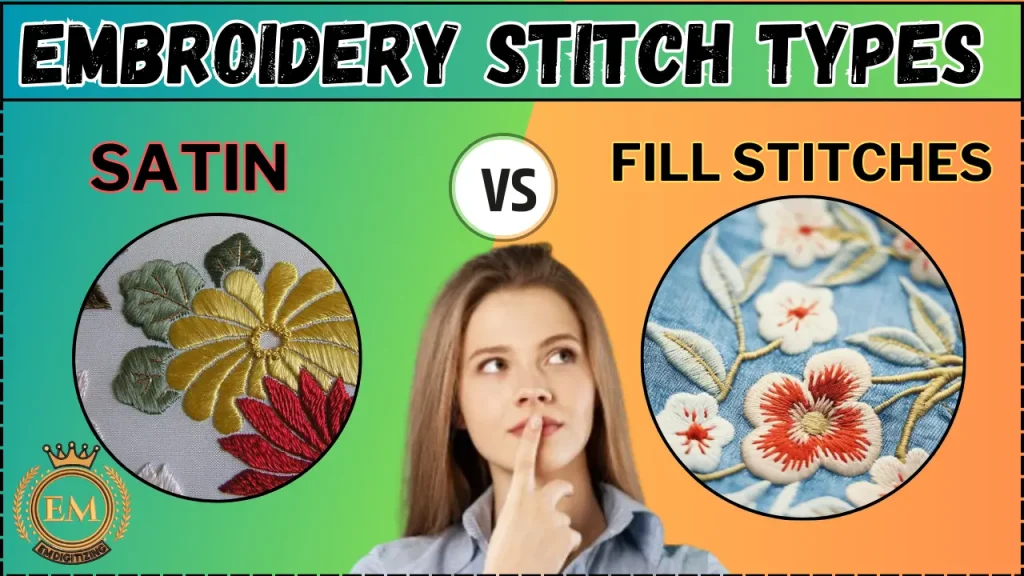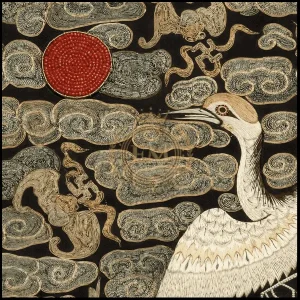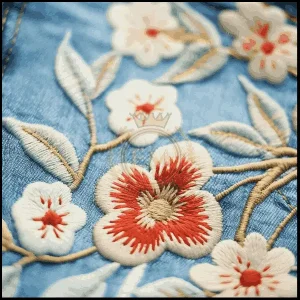Il ricamo a macchina è una forma d'arte accattivante che consente la creazione di disegni intricati e dettagliati su vari tessuti e indumenti. Due tipi di punto popolari utilizzati nel ricamo a macchina sono il punto pieno e il punto di riempimento.
In questo articolo, approfondiremo le complessità del punto pieno e del punto riempimento, esplorare le loro caratteristiche uniche, confrontare il loro aspetto e la loro consistenza, discutere i loro vari usi, e fornire approfondimenti sui fattori da considerare quando si sceglie tra di loro.

Che tu sia un principiante o un ricamatore esperto, questo articolo fornirà preziosi spunti sulla distinzione tra punto pieno e punto di riempimento nel ricamo a macchina.
Tipi di punti da ricamo: Spiegazione del punto satin e del punto di riempimento
Comprendere la tecnica: Punto raso
Il punto pieno è un punto fondamentale e versatile tecnica del ricamo noto per la sua morbidezza, aspetto brillante.
Definizione e caratteristiche del punto pieno
UN punto pieno è una tecnica in cui i punti paralleli vengono posizionati uno accanto all'altro per coprire completamente un'area.

I punti sono vicini tra loro, creando una finitura liscia e lucida, ricorda il tessuto di raso. I punti satin sono generalmente lunghi e stretti e spesso utilizzati per creare contorni, scritte, e dettagli intricati.
Come viene creato il punto pieno?
Per creare un punto cordoncino, la macchina si muove avanti e indietro in linea retta, con l'ago che penetra nel tessuto ad ogni passaggio.
I punti sono posizionati ravvicinati per garantire la copertura completa dell'area da riempire. La lunghezza e la larghezza dei punti possono essere regolate per ottenere effetti diversi.
Fattori che influenzano la qualità del punto pieno
Per ottenere un punto pieno di alta qualità è necessario prestare attenzione ai dettagli. Fattori come tensione del filo, densità del punto, e la scelta dello stabilizzatore può influire sul risultato finale.
It’;È importante scegliere il giusto peso del filo e tipo per il tessuto in uso, oltre a stabilizzare adeguatamente il tessuto per evitare grinze o distorsione.
Esplorare la tecnica: Punto di riempimento
Riempire il punto, una tecnica ampiamente utilizzata nel ricamo, è essenziale per aggiungere aree solide di colore o texture a un disegno.
Definizione e caratteristiche del punto di riempimento
Riempire il punto, Come suggerisce il nome, viene utilizzato per riempire aree più grandi all'interno di un disegno. A differenza del punto pieno, che consiste in singoli punti posizionati vicini tra loro, un punto di riempimento crea un solido, riempimento continuo cucendo righe o colonne di punti in un motivo.

I punti di riempimento possono variare in densità e sono comunemente utilizzati per sfondi e forme più grandi.
Come viene creato il punto di riempimento?
Per creare un punto di riempimento, il macchina da ricamo cuce righe o colonne di punti ravvicinati all'interno dell'area designata. I punti possono essere dritti o angolati, a seconda dell'effetto desiderato. La spaziatura tra i punti può essere regolato per controllare la densità del riempimento.
Fattori che influenzano la qualità del punto di riempimento
Per ottenere un punto di riempimento pulito e uniforme è necessario considerare attentamente fattori quali la direzione del punto, lunghezza del punto, e tensione del tessuto.
Una spaziatura costante e una corretta tensione del filo sono fondamentali per evitare spazi vuoti o ammucchiamenti all'interno del riempimento. Anche la scelta dell'angolo punto corretto può influire sull'aspetto del disegno.
Confronto tra le tecniche del punto pieno e del punto pieno
Il confronto tra le tecniche del punto piatto e del punto riempimento nel ricamo rivela approfondimenti sulle loro caratteristiche e applicazioni uniche.
Differenze nell'aspetto e nella consistenza
Il punto pieno crea una finitura liscia e lucida, ideale per contorni e scritte dettagliate. D'altro canto, il punto di riempimento crea un aspetto solido e sostanziale, perfetto per riempire aree più grandi e creare texture.

La scelta tra il punto pieno e il punto di riempimento dipende dall'aspetto e dalla sensazione desiderati del disegno di ricamo.
Variazioni nella flessibilità del design
Il punto pieno offre maggiore flessibilità nella creazione di linee sottili, curve, and intricate shapes due to its ability to closely follow the design’;s contorni. Riempire il punto, pur non essendo così versatile in questo senso, offre il vantaggio di coprire aree più grandi più rapidamente.

Considera la complessità del tuo progetto e il livello di dettaglio desiderato quando scegli tra le due tecniche.
Considerazioni sulla densità e lunghezza del punto
Il punto pieno richiede punti più lunghi per ottenere una finitura più liscia, ma un punto troppo lungo può far arricciare il tessuto. Riempire il punto, d'altro canto, possono essere cuciti più vicini per creare un aspetto più denso.

Prendi in considerazione il tipo di tessuto, dimensione del disegno, e l'effetto desiderato quando si determina la densità e la lunghezza del punto appropriate per il progetto di ricamo.
Ricorda, Sia il punto pieno che quello di riempimento hanno i loro punti di forza e possono essere utilizzati in combinazione per creare risultati dinamici e visivamente accattivanti disegni di ricamo a macchina.
Sperimenta diverse tecniche per scoprire il tuo stile personale e liberare la tua creatività!
Fattori da considerare quando si sceglie tra punto pieno e punto di riempimento
Quando decidi se utilizzare il punto pieno o il punto di riempimento nel ricamo a macchina, ci sono alcuni fattori da considerare.
Stile e disegno del ricamo
Lo stile e il design del tuo progetto di ricamo giocheranno un ruolo significativo nel determinare se utilizzare un punto pieno o un punto di riempimento.

Il punto pieno è perfetto per creare punti lisci, linee e forme eleganti, mentre il punto di riempimento è più adatto per riempire aree più grandi con colori o texture in tinta unita. Considera la complessità e la complessità del tuo disegno per determinare quale punto gli darà vita al meglio.
Tipo e struttura del tessuto
Another important factor to consider is the type and texture of the fabric you’;ricamerò. Il punto pieno funziona bene su tessuti lisci e leggeri, come la seta o il raso, poiché può scivolare dolcemente sulla superficie.
D'altro canto, tessuti strutturati o più spessi, come il denim o il pile, potrebbe trarre beneficio da un punto di riempimento, che può creare più dimensione e copertura.
Risultato finale e durata desiderati
Pensa al risultato finale desiderato il tuo progetto di ricamo e la sua destinazione d'uso. Il punto pieno può conferire un aspetto lucido ed elegante ai tuoi disegni, rendendolo adatto per pezzi decorativi o abbellimenti dettagliati.

Tuttavia, se la durabilità è un problema, il punto di riempimento potrebbe essere una scelta migliore, poiché può resistere a una maggiore usura grazie alla sua natura densa e robusta.
Applicazioni ed esempi di punto pieno e punto di riempimento nel ricamo a macchina
Il punto pieno e il punto riempimento hanno varie applicazioni nel ricamo a macchina, ed ecco alcuni esempi:
Abbellire Abbigliamento e Accessori
Il punto pieno può essere utilizzato per abbellire abiti e accessori, come aggiungere dettagli intricati a un colletto o accentuare una tasca.

Riempire il punto, d'altro canto, è perfetto per riempire aree più grandi come il corpo di una borsa o la parte anteriore di una felpa per creare disegni accattivanti.
Creazione di testi e loghi
Sia il punto pieno che quello di riempimento sono comunemente usati nella creazione di testo e loghi. Il punto pieno conferisce un aspetto elegante e professionale alle lettere e ai piccoli dettagli

mentre il punto riempimento può essere utilizzato per riempire lo sfondo e far risaltare il testo o il logo.
Aggiunta di texture e dimensioni ai disegni
Il punto di riempimento è eccellente per aggiungere consistenza e dimensione ai disegni. Può essere utilizzato per creare effetti realistici, come replicare la pelliccia o aggiungere un effetto 3D ai petali dei fiori.
Punto pieno, d'altro canto, può essere utilizzato per delineare e definire queste aree con texture, conferendo al design una finitura lucida.
Conclusione sul punto pieno o punto di riempimento nel ricamo a macchina
Insomma, sia il punto pieno che quello di riempimento hanno le loro applicazioni e punti di forza unici nel ricamo a macchina. Considera lo stile del tuo design, the fabric you’;stai lavorando con, e il risultato finale desiderato per determinare quale punto utilizzare.
Insieme a filo corretto e selezione dell'ago, stabilizzazione del tessuto, e regolazioni della macchina, puoi ottenere risultati di alta qualità con entrambi i punti.
Avanti così, divertiti a sperimentare, e lascia che la tua creatività risplenda attraverso i tuoi progetti di ricamo a macchina!
EMDigitalizzazione: Esperto di digitalizzazione del ricamo al tuo servizio
Se sei interessato a qualsiasi tipo di progetto di ricamo, allora EMdigitizing è la soluzione migliore per te. Noi offriamo digitalizzazione del ricamo e servizi di arte vettoriale con tempi di consegna rapidi. Puoi anche visitare e controllare il nostro sito web e i nostri migliori servizi.
Offriamo anche un ottimo 50% sconto su tutti i nostri servizi per i nostri stimati clienti per la prima volta. Offriamo anche preventivi gratuiti generato in appena 5 minuti.
Dovresti approfittare di questa offerta a tempo limitato e portare il tuo progetto di ricamo al livello successivo con EMdigitizing.
Se hai domande su questo argomento, puoi chiedere a loro. Grazie per aver dedicato del tempo a leggere questo articolo.
Domande frequenti:
Il punto pieno è spesso considerato il migliore per riempire lo spazio nel ricamo, in quanto crea una superficie liscia, denso, e anche la copertura. Questo punto è ideale per coprire aree più grandi con un aspetto elegante, consistenza lucida, rendendolo una scelta popolare per aggiungere solidi blocchi di colore.
Il nodo a lingotto è comunemente considerato uno dei punti di ricamo più difficili. Richiede un avvolgimento preciso del filo attorno all'ago e un attento inserimento nel tessuto, rendendo difficile ottenere risultati uniformi e precisi, soprattutto per i principianti.
Il punto continuo è in genere il punto di ricamo più semplice e basilare. Si tratta di semplici punti dentro e fuori che formano una linea tratteggiata sul tessuto. Questo punto è fondamentale nel ricamo e spesso è il primo punto imparato dai principianti.
Il punto indietro è noto per la sua resistenza e durata. Si sovrappone ai punti sul rovescio del tessuto, rendendolo robusto e ideale per contorni o dettagli che richiedono maggiore integrità strutturale in un disegno di ricamo.
La lunghezza del punto ideale nel ricamo varia a seconda del tipo di punto e dell'effetto desiderato. In genere, una lunghezza di 1/16 a 1/8 pollice (Di 1.5 a 3 mm) è comune per i dettagli più fini, mentre i punti più lunghi possono essere utilizzati per scopi di riempimento o decorativi. La chiave è la coerenza in lunghezza per un aspetto pulito e uniforme.
